
The Utah Territorial Statehouse, officially Territorial Statehouse State Park Museum, is a state park in Fillmore, Utah. The museum and park preserves the original seat of government for Utah Territory before the capital was moved to Salt Lake City in 1856. Built from 1852 to 1855, the statehouse was initially intended as a larger structure, but only the south wing was completed before the project was abandoned due to lack of federal funding. After its construction, the Utah Territorial Legislative Assembly met in the building for only one full session and parts of two others.

The Old State Capitol State Historic Site, in Springfield, Illinois, is a former capitol building for the U.S. state of Illinois, and one of two preserved former Illinois capitol buildings. It was built in the Greek Revival style in 1837–1840, when Springfield became the capital city, and served as the state house from 1840 to 1876, when it was replaced by the current capitol. It is the site of candidacy announcements by Abraham Lincoln in 1858 and Barack Obama in 2007. It was designated a National Historic Landmark in 1961, primarily for its association with Lincoln and his political rival Stephen Douglas.

The Vandalia State House, built in 1836, is the fourth capitol building of the U.S. state of Illinois. It is also the oldest capitol building in Illinois to survive, as the first, second, and third capitol buildings have all disappeared. The brick Federal style state house has been operated by the state of Illinois as a monument of Illinois' pioneer years since 1933. It is located in Vandalia, Illinois, on the National Road, and listed on the National Register of Historic Places.

The Old Scotch Church, also known as the Tualatin Plains Presbyterian Church, is a church and national historic site located in an unincorporated part of Washington County, Oregon, near Hillsboro, Oregon, United States. The church dates to 1873 while the church structure with an eight-sided steeple dates to 1878. A cemetery on the church grounds holds the graves of church members and local pioneer settlers of the Tualatin Plains, including Joseph Meek.

The Floyd and Glenora Dycus House is a historic house located at 305 S. Second St. in Brownstown, Illinois. The house was built in 1926 for Floyd and Glenora Dycus. Floyd Dycus was a prominent businessman in Brownstown; his businesses included a moving company, a dairy business, and a restaurant and truck stop on U.S. Route 40. Floyd also served as Brownstown's village president from 1929 to 1935. The house was built by carpenters Andrew and Charles Reeter from plans drawn by Glenora Dycus; it was designed in the Craftsman style. The entrance to the house is in a full-length front porch supported by tapered columns. The house has an intersecting roof pattern which features a half-hipped component protruding from a gable roof.

The Pioneer Gothic Church is located in the village of Dwight, Illinois, United States. The building is a rare example of an extant wood framed Carpenter Gothic church in the state of Illinois. The building was added to the U.S. National Register of Historic Places in 1983.
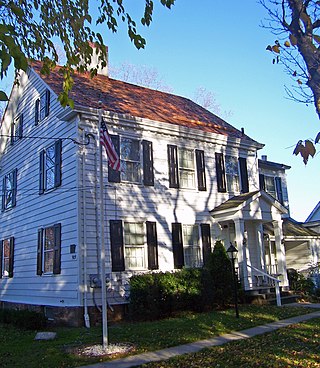
The Caldwell Parsonage is located at 909 Caldwell Avenue in Union Township of Union County, New Jersey, United States. It was the home of the Rev. James Caldwell, a Presbyterian minister and active supporter of the Patriot cause during the American Revolutionary War. In 1982 it was added to the National Register of Historic Places, as a well-preserved 18th-century farmhouse with a historical connection.

The Park United Presbyterian Church is located at 14 Cortland Street in Highland Park, Michigan. It was built in 1910 as the Highland Park Presbyterian Church, listed on the National Register of Historic Places in 1982, and designated a Michigan State Historic Site in 1983. It is a member of The Presbyterian Church (U.S.A.), and continues to offer services.

The Woodrow Wilson Boyhood Home is a historic house museum at 419 7th Street in Augusta, Georgia. Built in 1859, it was a childhood home of Woodrow Wilson (1856–1924), the 28th president of the United States and proponent of the League of Nations. The house is owned and operated by Historic Augusta, Inc., and was designated a National Historic Landmark on October 6, 2008.
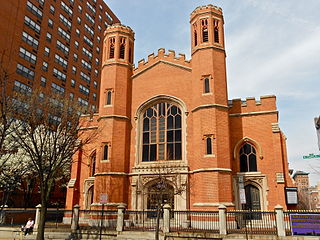
Franklin Street Presbyterian Church and Parsonage is a historic Presbyterian church located at 100 West Franklin Street at Cathedral Street, northwest corner in Baltimore, Maryland, United States. The church is a rectangular Tudor Gothic building dedicated in 1847, with an addition in 1865. The front features two 60 foot flanking octagonal towers are also crenelated and have louvered belfry openings and stained glass Gothic-arched windows. The manse / parsonage at the north end has similar matching walls of brick, heavy Tudor-Gothic window hoods, and battlements atop the roof and was built in 1857.

The First Presbyterian Church in Batavia, New York, United States, is located at East Main and Liberty streets. It is a joined complex of several buildings. The main one, the church's sanctuary, is a limestone Gothic Revival structure built in the mid-19th century. Its congregation was the first church to be organized in Batavia, albeit as a Congregationalist group at that time.
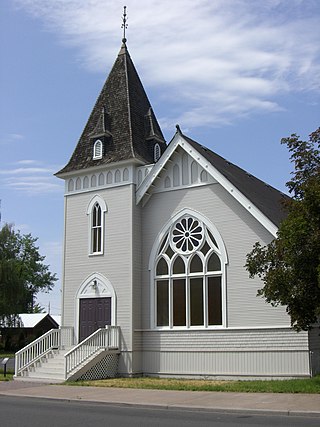
Built in 1912, the First Presbyterian Church of Redmond is the oldest standing church structure in the city of Redmond, Oregon, United States. It is also the second-oldest religious building in Deschutes County. The church was built in the Gothic Revival style with Queen Anne architectural detailing. It was the home of Protestant congregations from 1912 until 1979. Today, the building is privately owned and used as a special events venue. The First Presbyterian Church of Redmond was listed on the National Register of Historic Places in 2001.

The Grosse Pointe Memorial Church (GPMC) is a church located at 16 Lake Shore Drive in Grosse Pointe Farms, Michigan, USA. it is a member of the Presbyterian Church, USA (PCUSA). It was designated a Michigan State Historic Site in 1990 and listed on the National Register of Historic Places in 1993.

Gethsemane Lutheran Church is a historic Lutheran church in downtown Austin, Texas. It is designated as a Recorded Texas Historic Landmark and is listed on the National Register of Historic Places along with the neighboring Luther Hall. The building currently houses the offices of the Texas Historical Commission.

First Presbyterian Church is a Presbyterian Church (USA) church located in Muscatine, Iowa, United States. It, along with the attached Sunday School building, were listed on the National Register of Historic Places in 1977.
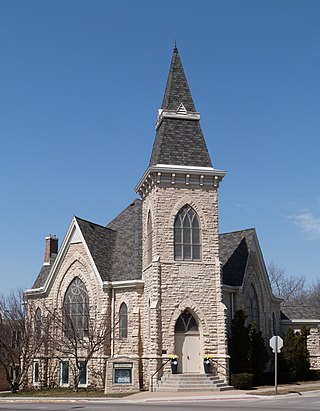
First Presbyterian Church is located in Marion, Iowa, United States. It was listed on the National Register of Historic Places in 1992.
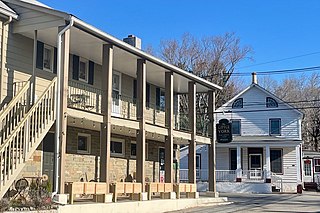
Little York is an unincorporated community located along the border of Alexandria and Holland townships in Hunterdon County, in the U.S. state of New Jersey. Little York is located on County Route 614 3.1 miles (5.0 km) north-northeast of Milford. Little York has a post office with ZIP Code 08834.

Reaville is an unincorporated community located along the border of East Amwell and Raritan townships in Hunterdon County, New Jersey. By the 1830s, it was known as Greenville. It was later renamed after Runkle Rea, the first postmaster in 1850.

The Fayette County Courthouse is a government building in Vandalia, the county seat of Fayette County, Illinois, United States. Converted from a residence in the 1930s, it succeeded a former state capitol as the courthouse for Fayette County.

The Jerseyville First Presbyterian Church is a historic Presbyterian church at 400 South State Street in Jerseyville, Illinois. The church was built in 1882 to replace Jerseyville's Presbyterian congregation's original church, which had been built on the same site in 1841. The congregation itself formed in 1834, making it the first church of any sort in the county. Architect James Roland Willett of Chicago designed the church in the High Victorian Gothic style, which was commonly used for rural religious buildings at the time. The church has a limestone exterior built with stone from nearby Grafton, and its design includes a corner bell tower with a steeple, pointed arch windows and doors, and a complex roof with a front-facing gable.






















